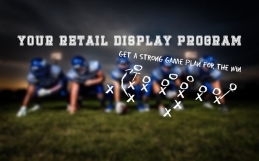![]() As technology continues to boom, the retail customer experience is simultaneously being revolutionized. One particular technology that emerged onto the scene in 2013 is the use of location-based technology, also known as beacons.
As technology continues to boom, the retail customer experience is simultaneously being revolutionized. One particular technology that emerged onto the scene in 2013 is the use of location-based technology, also known as beacons.
What is a Beacon?
A beacon, often referred to as an ibeacon, is a small device, around the size of a pebble, that retailers can stick to objects or walls of a retail store. They emit a bluetooth low-energy (BLE) wireless signal that connects to customers’ portable devices, tracking their location within or nearby a store. The BLE signal emitted by the beacon is only received by a specific app compatible with, and within range, of the beacon’s signal. Once an app detects a beacon signal, a message is sent to the customer’s phone with a personalized coupon or deal to use in the store.
Where Did it Begin?
The Bluetooth Low-Energy technology (BLE) was first developed by Nokia back in 2001, laying the foundation for beacons. However, this technology didn’t really emerge onto the retail scene until 2013 when Apple announced their own BLE compatible protocol, the ibeacon. Apple rolled out the ibeacon in December 2013 across 254 retail stores nationwide, bringing the BLE technology to the masses. The ibeacon, which works in conjunction with Apple’s iOS software, allows your iOS device to constantly roam for BLE signals. When an iOS device comes within range of an ibeacon signal, it alerts the necessary apps — even if they are closed. Apple devices can also act as ibeacons themselves, emitting signals as well as just receiving them, and waking up relevant apps on other devices.
How Are Beacons Benefiting Retailers?
Beacons could revolutionize the way customers shop by creating a highly personalized retail experience. While purchases made at traditional brick and mortar stores still dominate total retail sales, more and more people are converting to online shopping from the comfort of their home or while on the go. In fact eMarketer predicts that 25% of retail purchases will be through e-commerce by the end of 2016. Beacons could help brick and mortar stores win back sales from ecommerce. Almost all customers nowadays that enter a store are carrying some kind of smart device, whether a smartphone or a tablet. If more stores implement beacons, customers could be alerted with personalized coupons and deals as soon as they enter a store. Business Insider expected beacons to directly influence over $4 billion worth of US retail sales in 2015 at top retailers with that number increasing tenfold in 2016. A select handful of retailers have already implemented beacon technology. Macy’s, Target, and Apple have rolled out beacon technology in stores across the US, with other retailers soon to follow suit.
The Future of Beacons
If beacons really take off in retail, their implications could be endless. Not only will brands and retailers be able to send highly personalized offers and deals as soon as a customer enters the store, but they will be able to collect data on customers’ locations which could prove to be invaluable information for the future of retail. This location-based technology will enable retailers to see where customers spend the majority of their time in the store and what areas are most frequently visited. This could help with decisions involving planning store layouts and could help drive the cost of retail space.
Beacons are also becoming more popular as a contactless payment method. If this takes off, then customers could enter a store, receive personalized deals, and pay, without even meeting a single employee.
So What’s the Issue?
While in theory this technology seems like there would be no reason retailers shouldn’t be pouncing on the idea, there are a few factors inhibiting the growth of beacon implementation in retail. One reason is that in order for the beacon to work, there needs to be an app compatible with the specific beacon signals. If the retailer or brand doesn’t have a beacon-enabled app, then the signals from the beacon will never be received. Not only can developing an app be time consuming and pricey, but the customer also must have it installed on their device. If the app isn’t installed then that customer will never receive any messages. Also right now, ibeacons are advantageous to idevice users, since ibeacon allows these devices to constantly search for beacons even if all apps are closed. Android users however must have the specific app installed and open in order to search for beacon signals. This puts more strain on their battery, and decreases the chance of android users being alerted by beacons. That being said, Facebook and Google have recently joined the trend with their own beacons, proving that beacons are still only beginning to develop and may be a major key in the future of retail.
Do You Need Point of Purchase Displays?
If you, or your company, are new to the world of Point of Purchase Displays, and you are looking to create a program for your company or product, let Concept Designs help. We have over 20 years experience designing, engineering, and managing the production of custom retail displays. We would love to hear from you.
Want to see more of our work? Click here.

